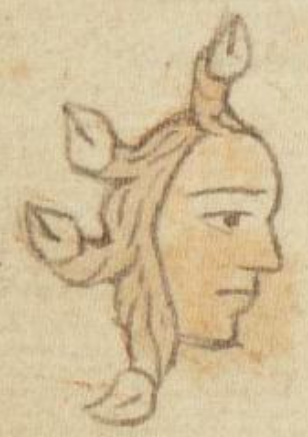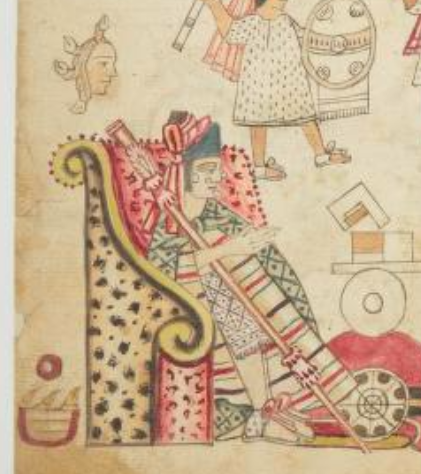Axayacatl (Azca25)
This painted black-line drawing of the compound glyph for the personal name Axayacatl (literally, “Water-Face,” and possibly intending “Face of Water”) shows a curving stream of water (atl) with four splashes, each with a shell at the end. This water curves around the back side of a face (axayacatl) in profile, facing right. The face is a flesh tone, the water is tan, and the shells are white or natural. Small lines of current or waves suggest movement in the water.
Stephanie Wood
There are no glosses for this glyph, but we are calling it a glyph nevertheless, given that it is expected in the lineup of rulers in this manuscripts, and this glyph looks something like the glyphs for Axayacatl that appear in the Codex Mendoza. The two examples of the compound glyph for Axayacatl (indeed from the Codex Mendoza), included in this collection, both show the water streaming down the front of the face in profile rather than the back of the head. The water on the face does call more attention to that part of the head, which represents a key part (-xayacatl) of the place name.
For another rendition of the glyph for Axayacatl, see Marc Thouvenot's vignette about an image from the Códice Matritense de la Real Academia, https://vignettes.sup-infor.com/imagen/5-RA_01_051r_f. In that one, the water curves around the top of the head and spills down over Axayacatl's face.
Stephanie Wood
post-1550, possibly from the early seventeenth century.
Jeff Haskett-Wood
caras, agua, nombres de hombres, nombres de personas famosas

Axayacatl, a ruler in Mexico-Tenochtitlan, greatly expanded the empire, https://nahuatl.wired-humanities.org/content/Axayacatl
a(tl), water, https://nahuatl.wired-humanities.org/content/atl
xayaca(tl), face, https://nahuatl.wired-humanities.org/content/xayacatl
Cara de Agua
Stephanie Wood
The Codex Azcatitlan is also known as the Histoire mexicaine, [Manuscrit] Mexicain 59–64. It is housed in the Bibliothèque Nationale de France, and hosted on line by the World Digital Library and the Library of Congress, which is “unaware of any copyright or other restrictions in the World Digital Library Collection.”
https://www.loc.gov/resource/gdcwdl.wdl_15280/?sp=25&st=image
The Library of Congress is “unaware of any copyright or other restrictions in the World Digital Library Collection.” But please cite Bibliothèque Nationale de France and this Visual Lexicon of Aztec Hieroglyphs.



